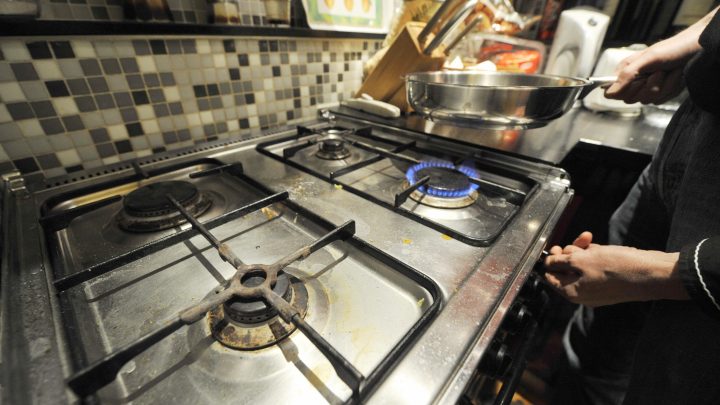
Amid gas stove debate, manufacturers hope the induction market will heat up
Amid gas stove debate, manufacturers hope the induction market will heat up

Nick Troutman is a fairly serious home chef.
“I enjoy cooking,” he said on a recent weeknight while peeling garlic for the lemon pepper chicken crackling on his induction cooktop. “I follow a bunch of [food-related] social media accounts. This recipe is coming from a TikTok.”
When it came time to boil water for the orzo, he was excited to show me how fast induction technology could do it. I broke out my iPhone stopwatch. We saw some lazy bubbles coming up around a minute, which reached a slow boil about 30 seconds later.
“It’s a really fun party trick,” Nick said.
When he and his partner Meredith bought their house in Albuquerque, they hoped to replace the ancient electric coil range with a gas stove.
“It’s what we knew growing up. It seemed the most respectable. It’s the most fun,” Nick said. But it turned out that installing a gas line was going to cost something like $2,000.
“It was a whole big thing. And instead, [a salesman] said ‘Hey, try induction.’ We thought originally this would be electric 2.0. It sounded awful.”
But that salesman at an appliance wholesaler hit Nick and Meredith with the speedy water boiling trick. Now, they too can boil water in under two minutes. “It’s a good sell,” he said with a laugh.
Earlier this year, natural gas cooking became a flashpoint in the culture wars. And while the Biden administration isn’t trying to take away your gas stove, it is looking to nudge the transition by launching a federal rebate for the purchase of electric appliances and possibly strengthening efficiency standards for newly manufactured gas stoves.
Meanwhile, cities like Seattle, LA and New York have moved to ban natural gas appliance hookups in new construction for the sake of public health and the planet.
Some manufacturers are hoping these new restrictions will come with a silver lining: a new market for induction stoves and cooktops, which use a copper coil and electromagnetism to heat pots and pans rather than relying on indirect radiation.
“Induction is really heating up,” so to speak, said Jill Notini with the Association of Home Appliance Manufacturers. “In the past five years, we have started to see about a 3% average annual growth rate [in sales].”
Induction — which has been around since the 1970s — makes up just a 5% sliver of the overall electric cooking market. Still, manufacturers are ramping up production and investing in consumer education about the technology, she said.
“For many years, people thought that they needed to have special pots and pans in order to work with induction,” Notini said.
You do need magnetic cookware, however — like stainless steel or cast iron. If you can’t part with your ceramic dutch oven, induction might not be for you. Another major hurdle is home electrification.
“It is possible in some situations that you would need to upgrade your electric panel in order to accommodate the amperage,” she said.
That can especially be true in very old homes, and rewiring can be prohibitively expensive. A couple of startups are working on that problem — like Impulse Labs in San Francisco. Founder Sam D’Amico was looking to revolutionize home cooking appliances.
“We were thinking about ways to like, cook pizza really fast,” he said. “We realized if you could integrate a battery pack in there, then you can essentially decouple the performance of the appliance from like what power source you might have from the wall.”
Impulse is developing an induction cooktop that runs partially on battery power. D’Amico plans to launch within the year. But he said the industry also faces a marketing problem that’s much squishier.
“There is, like, a ritual aspect of cooking and meals,” D’Amico said. And a lot of home cooks were emotionally attached to cooking with fire even before it got political.
“When you’re trying to rock the boat on something so basic to the human experience, it’s like you’re coming up against social pressures that may not even be put into words,” he said.
In his Albuquerque kitchen, Nick Troutman tried to put his finger on the difference: “It doesn’t have the same romance to it,” he said.
Functionally, he’s pretty sure his induction cooktop produces the same results as gas, if not better. “It’s pretty seamless,” he said. “The only single thing is, you can’t roast marshmallows.”
But he has a dedicated heat gun for that anyway.
There’s a lot happening in the world. Through it all, Marketplace is here for you.
You rely on Marketplace to break down the world’s events and tell you how it affects you in a fact-based, approachable way. We rely on your financial support to keep making that possible.
Your donation today powers the independent journalism that you rely on. For just $5/month, you can help sustain Marketplace so we can keep reporting on the things that matter to you.











